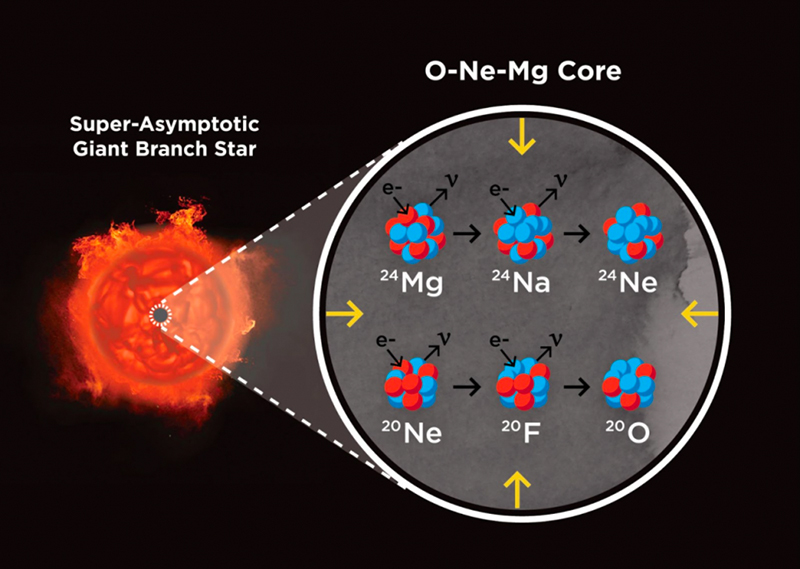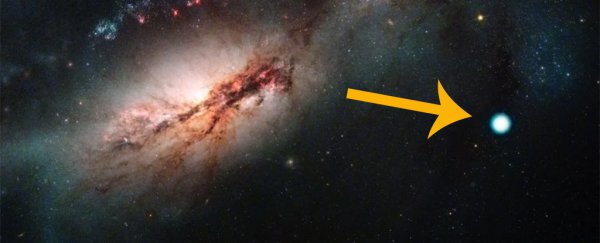Way back in 1054 CE, a supernova stellar explosion lit up the skies with enough brightness that it could be seen from from Earth during the daytime, for 23 days straight.
Its remnants still exist today as the Crab Nebula, and new research gives us our best idea yet of exactly what happened to cause such a phenomenon.
Based on an analysis of a more recent supernova labeled SN 2018zd, astronomers think both SN 2018zd and the 1054 CE supernova are electron-capture supernovae – a rare third type of supernova alongside type I (thermonuclear) and type II (core collapse).
Experts have hypothesized about this third type of exploding star for decades at this point, though actual physical evidence of electron-capture supernovae has been difficult to come by. The unusual characteristics of SN 2018zd – a mere 31 million light-years away – may be the first one we've actually properly identified.
"This supernova is literally helping us decode thousand-year-old records from cultures all over the world," says astrophysicist Andrew Howell, from the University of California, Santa Barbara (UCSB). "And it is helping us associate one thing we don't fully understand, the Crab Nebula, with another thing we have incredible modern records of, this supernova.
"In the process it is teaching us about fundamental physics: how some neutron stars get made, how extreme stars live and die, and about how the elements we're made of get created and scattered around the Universe."
Every star is in a constant battle with gravity, with either ongoing fusion or densely packed atoms prolonging its lifespan. In the case of supernovae, typically either an increase in mass leads to a runaway thermonuclear explosion (type I), or the star runs out of fuel and its iron core collapses (type II).
Even before this discovery though, scientists suspected a third scenario: where electrons in a star's oxygen-neon-magnesium core get smashed into atomic nuclei, causing it to collapse under its own weight. A very precise balance is required for this, otherwise the star is too heavy or light to be pulled into its death throes in this particular way.
 Artist impressions of a super-asymptotic giant branch star and its core. (S. Wilkinson; Las Cumbres Observatory)
Artist impressions of a super-asymptotic giant branch star and its core. (S. Wilkinson; Las Cumbres Observatory)
Scientists had already figured out that an electron-capture supernova should form from a rare and massive super-asymptotic giant branch (SAGB) star, and meet five other criteria – extensive mass loss before the supernova phase, an unusual chemical composition, a weak explosion, low radioactivity, and a neutron-rich core.
Using archival images taken by the Hubble Space Telescope before SN 2018zd exploded, as well as more recent readings post-explosion, astronomers noticed that SN 2018zd met all six indicators for an electron-capture supernova – the first supernova on record to do so.
"We started by asking 'what's this weirdo?'" says astrophysicist Daichi Hiramatsu, from UCSB. "Then we examined every aspect of SN 2018zd and realized that all of them can be explained in the electron-capture scenario."
While it was previously thought the Crab Nebula was the result of an electron-capture supernova, it's much trickier to try and piece together the physics of an explosion that was observed from Earth a thousand years ago. The new research makes it more likely that the 1054 CE event was a type III explosion, and partly explains its brightness.
The team thinks the material cast off by the exploding star collided with the remnants of the supernova, increasing its luminosity in the sky, because exactly the same effect was observed to happen for SN 2018zd.
Astronomer Ken Nomoto from the University of Tokyo in Japan, who made that first prediction of electron-capture supernovae back in 1980, has been able to see his hypothesis backed up with new findings discovered more than four decades later.
"I am very pleased that the electron-capture supernova was finally discovered, which my colleagues and I predicted to exist and have a connection to the Crab Nebula 40 years ago," says Nomoto.
"I very much appreciate the great efforts involved in obtaining these observations. This is a wonderful case of the combination of observations and theory."
The research has been published in Nature Astronomy.
